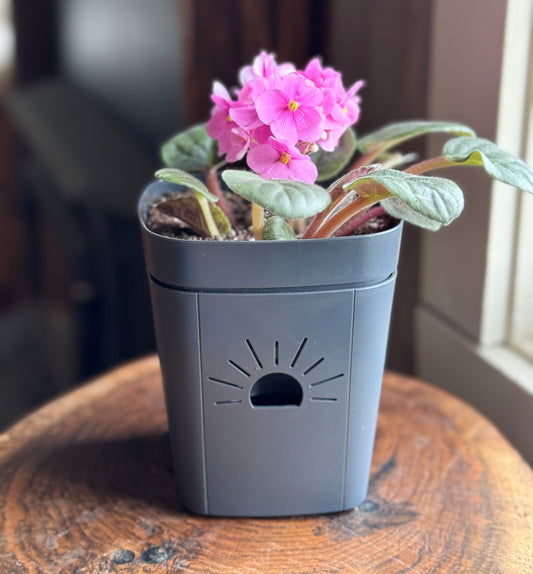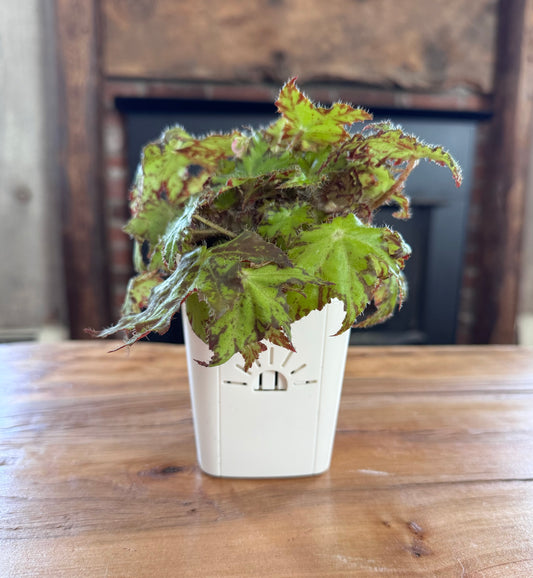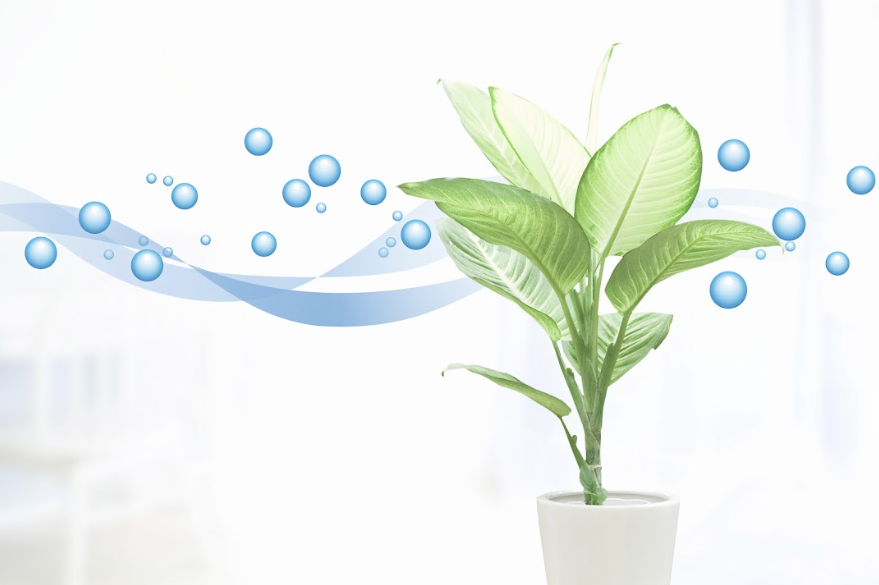Tuberous: These grow from an underground tuber and have big flowers.
Fibrous: These have fibrous roots only and make excellent outdoor bedding plants.
Rhizomatous: These have a thick rhizomatous underground stem that grows horizontally. They have the largest leaves of all begonias.
Begonias also have attractive foliage, which makes them popular houseplants. The leaves may be green, red, bronze, silver, or patterned with circles, dots, or stripes, depending on the type of begonia. With proper care and attention, they will last for many years!
Origins
Begonia (Begoniaceae) is one of the largest genera of flowering plants, containing 2,002 species. They grow naturally in subtropical and tropical moist climates, such as South and Central America, southern Asia, and Africa. These plants typically grow on or near the ground and have unisexual flowers, with male and female flowers on the same plant. The leaves are usually quite large, have various markings or colors, and are asymmetrical. The fruit is a winged capsule with numerous tiny seeds inside.
Light
Requirements
When growing begonias, it is important to understand the cultural requirements. Most species originate from tropical environments and need warm temperatures to thrive. Additionally, since most are native to forest understory areas, they require bright shade and not full sun exposure – this is especially true in climates with higher temperatures.
Begonias can tolerate some direct sunlight but should not be exposed for too long or during the hottest parts of the day. It’s also important to keep an eye on how much light your begonia receives – too little will cause weakened growth, while too much can lead to leaf scorch or other damage caused by intense light rays.
The ideal light for most begonias is a bright shady place with dappled sunlight in the morning.
Genus Summary
| GENUS | Begonia |
| COMMON NAMES | Begonia |
| LIGHT | Low. Prefers bright shade |
| WATER SCHEDULE | 7 days |
| WATER REQUIREMENTS | Keep the soil evenly moist but not soggy. |
| HUMIDITY | High |
| TEMPERATURE | 70-80°F day and 60° Night. Never below 50° |
| FEEDING | 1x month |
| TOXICITY | Mildly |
| PESTS | Aphids, thrips, whiteflies, long-tailed mealybugs |
| DISEASES | Fungi: Pythium, Rhizoctonia, and Fusarium |
| POT | Maximum aeration |
| SOIL | Soilless mix |
| FERTILIZER | Diluted with micronutrients |
| PROPAGATION | Leaf, steam, division (rarely seed) |
| PRUNING | Medium |
| SIZE | 6” to 8’ |
Water Requirements
If growing a begonia in a Naked Root planter, you can follow a 7-day watering schedule.
When watering begonias, it is vital to choose a well-drained growing medium that will not stay wet or dry out completely. The soil should be kept consistently moist but never soggy. During the winter months, reduce the amount of water applied and stop altogether for tuberous begonias. Waterlogged soil can cause root rot and other issues.
Humidity
Too much water can be detrimental for begonias, but they still require a relatively humid environment to thrive. This delicate balance of moisture and humidity should be monitored carefully in order to keep your plant healthy. As these plants are native to tropical climates, they love the high levels of humidity present there. To replicate this atmosphere indoors, you can place potted begonias on top of a pebble tray with some water in it. The evaporation from the water raises the humidity around the plant while also avoiding overwatering, which could cause root rot.
Temperature
Generally, begonias prefer 70-80°F during the day and 60 degrees at night. In climates that are not tropical or subtropical, begonias can easily be grown as house plants. They don’t tolerate cold well, and temperatures below 50 degrees can harm the plant. If you live in an area where the temperatures drop to 50 degrees or lower, your potted begonias can still benefit from a trip outside into a bright shady spot in the summer.
Toxicity
The taste of most begonias is sour, so they are rarely consumed in large enough quantities to cause harm. Eating a small amount is safe, but consuming large quantities may be toxic due to the plant’s high levels of oxalic acid.
Pests and Diseases
Many begonias are susceptible to sap-sucking pests, such as aphids, thrips, and whiteflies. Insecticidal soaps are often the most effective treatment against these pests. Long-tailed mealybugs are also prevalent in begonia plants and may be harder to remove. Rubbing alcohol applied to a cotton swab is usually effective in dislodging them from the plant.
Begonias are prone to certain fungal diseases. Seedlings can be affected by Pythium fungi, which results in damping off. In more mature plants, the stems and petioles may develop shiny black areas of rot near the soil line, leading to death. Rhizoctonia fungi can also lead to root rot and eventual collapse. Fusarium fungi cause damping off as well as root rot damage in tuberous begonias.
The most effective way to deal with pests and diseases is to prevent them from occurring in the first place. To prevent fungal and bacterial infections, ensure air continually circulates around the roots and avoid watering from above
Pot
Begonias do well in a pot with excellent airflow. In their natural environment, they grow in loose plant litter under trees, and their root systems are not buried under the soil deeply. Some begonias are epiphytes and grow entirely off the ground in their tropical homes.
Repotting begonias is infrequent. If the roots have filled the pot, it is time to repot the plant. You can tell this is necessary if the roots cling to the potting soil when you carefully lift the plant out of its pot.
Soil
Begonias need soil that is rich, humusy, and drains well while staying slightly moist. It should also be well-ventilated and not too dense. A soilless mix is the best for achieving this, and if you are preparing your own mix, use three parts sphagnum peat, two parts perlite, and one part vermiculite.
Fertilizer
Begonias need a variety of nutrients, including micronutrients, to be healthy. To ensure that your plants consistently get the nutrition they need, use a diluted liquid fertilizer regularly. Make sure you use the right amount for the recommended period of time. For example, if you’re supposed to fertilize monthly, try using a quarter of the dosage each week.
Switching out different fertilizer brands is also beneficial since they have different trace minerals that your plants need. A 10-10-10 or 15-15-15 diluted liquid fertilizer is usually a good choice for basic feedings, making sure to dilute it in water as too strong of fertilizer can burn the leaves.
Propagation
Begonias can be propagated in various ways, including division, stem cuttings, or even sections of leaves from the rhizomatous or rex groups. Starting begonias from seed is complex and not typically recommended. Leaf cuttings are the simplest form of propagation, as even a leaf fragment can take root as long as it has a major vein present. If unsure of the vein’s position, it is best to plant the entire leaf.
You can propagate begonias through stem cuttings or rhizome cuttings. Depending on the type of begonia, stem cuttings need to have nodes with buds on them to grow a proper plant after rooting. With rhizome cuttings, segments should be cut and planted halfway up the rhizome’s sides. It can be difficult for rhizome cuttings to take root, so starting from a leaf cutting is easier.
Tuberous begonias develop large tuberous roots that you can separate with your hands. As long as each piece has an eye or a stem, it can be planted separately and will grow into a new plant.
Pruning
All kinds of begonias need pruning, but the amount of pruning needed will vary depending on the type. Pruning can help create a bushier plant and reduce any spindly growth.
Before beginning, use clean tools or wash your hands if you pinch the plant with your fingers. This hygiene will prevent any diseases from being spread.
Cane begonias can become quite tall and, therefore, need pruning. Cut the tallest stems back by two-thirds of their height during the spring or early summer. This trim will cause new leaves and stems to grow at the base of the plant, resulting in denser foliage.
For tuberous begonias, you can train them to produce bigger flowers. To do this, pinch off any extra flower buds at the sides of the stem, leaving only one bud at the end of the stem. This procedure will direct the plant’s energy into creating one eye-catching flower instead of several little ones. When the flowers start to wilt and fade, it’s a good idea to pinch them off, as this can help encourage more blooms.
10 Striking Varieties and Cultivars
The begonia genus is particularly diverse, having species from around the world. This wide variety of plants makes it possible for them to hybridize with each other, thus creating an incredibly large number of cultivars. The sheer range of cultivars available means that you can find a begonia for nearly any environment or situation. Whether you’re looking for a small houseplant to sit on your windowsill or a large outdoor plant for your shade garden, there’s sure to be a cultivar that will suit your needs.
- Begonia maculata ‘Wightii’ – This particular Begonia species adds a lot of visual appeal to any indoor environment with its eye-catching leaves. Its nickname, the Polka Dot Begonia, is derived from the white spots across its olive-green surface. Each leaf has a bright red underside. This type of begonia is part of the angel-winged variety and is not too demanding when it comes to care. When happy, it will produce pink bell-shaped flowers.
- Begonia ‘Gryphon’ – This begonia has beautiful star-shaped leaves. The leaves are large and silvery-green with red and purple veins. This variety is easy to care for and propagates from a single leaf.
- Begonia pavonina – This begonia from Malaysia has iridescent leaves! They are a startling blue color on top and copper-colored underneath. It gets the nickname peacock begonia for its exotic foliage. With extra high-humidity needs, this one might be best grown in a terrarium.
- Begonia ‘Lucerna’ – Here, we have another angel wing begonia. This one has olive green leaves covered in white polka dots on the top and bright burgundy on the underside. The nickname for this plant is bat-wing begonia because of the long leaves that are round on top, elongated, and pointy toward the end. It can grow to 4 feet tall indoors and 8 feet tall outdoors! When happy, it will produce bunches of reddish-pink flowers.
- Begonia ‘Pink Minx’ – The Begonia’ Pink Minx’ variety is a beautiful plant with alluring pink foliage and blooms. The leaves have pronounced indentations, with light pink splashes against the dark green. The pink flowers dangle in bunches and are enchanting. Pink Minx thrives in a more humid environment than other begonia varieties. To encourage a more lush and full look, pinch off the ends of the stems.
- Begonia ‘Rex’ – Rex begonias are one of the most common types to find for sale at your local garden center. And they are popular for a good reason. They are easy to grow, propagate from any leaf or stem, and are rarely bothered by any pest or disease. The silver leaves are trimmed red and have dark purple (nearly black) veins. The stems and new leaves are bright red and darken with age.
- Begonia ‘Nonstop Rose Petticoat’ – If you are looking for an outdoor patio begonia, this is an excellent choice. It blooms continuously from spring until a hard frost in the fall. The multi-colored pink flowers are fully double and nearly 5 inches across, looking more like peonies than begonias. Plant in a bright shady spot, and enjoy a 12-inch tall bushy plant covered in blooms all season.
- Begonia ‘Marmaduke’ – The ‘Marmaduke’ cultivar is particularly special due to its stunning appearance. Its leaves are maple-shaped, with dark brown spots on a bright yellow background. As if this wasn’t enough, it also produces wonderful white blooms in the later winter months.
- Begonia ‘Fireworks’ – Begonia ‘Fireworks’ features an extraordinary leaf pattern consisting of different shades of purple, pink, and metallic silver that look like a beautiful firework display. This low-maintenance plant also produces attractive pink flowers, making it a great addition to any indoor garden. To keep it healthy, provide it with bright shade, high humidity, and warm temperatures.
- Begonia ‘Red Kiss’ – This plant has candy-red leaves with black star-shaped patterns in the middle. It is known for its compact growth and makes an excellent indoor plant for a small space. It is not fussy and requires only a northern window, plenty of air circulation, and consistent moisture to thrive.
Summary of Begonia Plant Care
Begonia needs consistent moisture but not soggy soil. They thrive indoors in bright shade and a soil-free planting medium. They require a pot with maximum root zone aeration and fertilizer with ample micro-nutrients. Keep humidity levels high, and your begonia will live for many years!





 Verified Buyer
Verified Buyer









